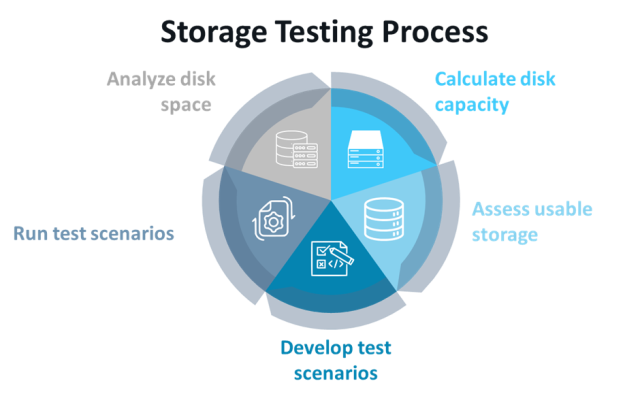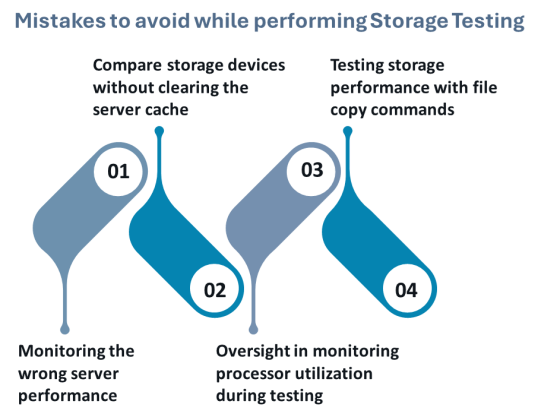The rate at which data is growing can blow your mind. By 2025, it is estimated that the global datasphere will increase to 175 zettabytes – Sigma. Another report by Sigma states that around 2,000,000,000,000,000,000 bytes of data are generated every day across all industries.
But what happens when there is no space to store and manage this data? Well, in situations like these, it is most likely that systems may slow down or crash hindering the performance of business operations.
What can businesses do to handle this situation? The most recommended method to ensure storage systems perform at their peak and in a reliable manner is to sign up for storage testing services. Whether working with an on-premises setup or having your data hosted on the cloud, storage testing solutions are the panacea. Businesses need to understand that thorough storage testing methods can be effectively leveraged to identify potential issues such as sufficient space to store data and check if data is read from appropriate directories to avoid stack overflow.
In this fast-paced world where data is the new gold, storage testing has become an integral part of the business strategy to identify potential bottlenecks, ensure data integrity, and maintain high availability. Given the gravity of healthy storage solutions, our blog is focused on delivering a step-by-step guide on the topic to give detailed insights into storage testing solutions. Right from getting the basics right, we will shed light on aspects such as types of storage testing, storage testing process, trends in storage testing, and a lot more.
Decoding the concept of storage testing
A software application or a digital service is directly proportional to the data it gets to operate on. However, it goes unsaid that businesses need to ensure high-quality data storage for uninterrupted performance. The Quality Assurance (QA) expertise is growing into fresher innovative paradigms to keep delivering a seamless customer experience.
Storage testing is nothing but an extended version of QA that ensures your Storage Network Area (SAN), Software-Defined Storage (SDS), Cloud Storage, and other storage technologies are at their peak.
On the technical front, storage testing is a technique that manages the storage element in terms of disk allotment, data distribution, and more. When deployed strategically, it analyzes if there is enough space or memory in the database to store data and information. At the same time, it keeps a check on the memory storage for low space issues and in such situations makes sure that data is terminated and stored at a different location. Additionally, storage testing services verify if the software reads and stores data in and from the correct directories.
As mentioned before, storage testing evaluates storage systems such as SSDs, SAN, NAS, hard drives, and Cloud to ensure they meet performance, reliability and scalability standards of a business. This testing method is adept at assessing speed (which is the throughput), data integrity, latency, and system resilience under a range of workloads and conditions. The primary aim is to identify probable blocks and verify the compatibility quotient with other hardware and software. Additionally, it verifies the security aspect to protect data and maintain business integrity.
By carrying out comprehensive storage testing, businesses can bridge the gap between storage infrastructure and operational needs, while maintaining optimal performance by reducing the risk of data loss and system failures.
In a digital space where data is the primary element responsible for success, storage boxes happen to be the backbone of enterprise data management. To explore this arena in detail, check out our blog on How to Perform Hardware and Firmware Testing of Storage Box
The storage testing objective
Storage testing is an essential step toward the prevention of storage-related issues. The primary goal is to ensure storage systems are up and running under different conditions and workloads. This entire gig involves evaluation of aspects such as reliability, performance, and security.
Some of the common objectives of this genre of testing are:
- To get a clear idea about storage limits before deployment
- To understand how the system responds when new hardware is replaced, or the existing device is updated
- To reduce response time
- To accelerate processing
Types of storage testing
Before we get to understand in detail about the various types of storage testing methods that exist, it is crucial to know that storage systems are the backbone data management strategy for any given organization, irrespective of its size, or industry. By performing storage testing, businesses can ensure effective storage of critical information, its retrieval, and security. By carrying out comprehensive testing, organizations can be in a better position to meet both the current and future needs related to data storage. Here are a few significant types of storage testing to consider:
Performance Testing: This storage testing type is deployed to analyze the speed and efficacy of storage systems under various workloads. It measures metrics such as read/write speed, Input/Output Operations per Second (IOPS), and latency to confirm the storage system can deal with high-demand circumstances without having to bear the brunt of notable slowdowns.
Reliability Testing: Under reliability testing, the process is done to evaluate elements such as stability and fault tolerance of storage solutions over time. This focuses on parameters like testing of data integrity, errors, and the storage systems’ readiness to bounce back from failures. By deploying this process, businesses can ensure the storage system delivers a steady performance even on occasions of hardware and software issues.
Scalability Testing: As the name suggests, scalability testing focuses on the effectiveness of the storage system to adjust and include growing volumes of data. Scalability testing checks can be extremely useful in expansion of storage capacity and improve performance, without having any negative effect on existing operations.
Data Integrity Testing: Businesses must undertake this type to ensure data stored on the system stays relevant, and unchanged over time. Its strategic application helps check for data corruption, confirms if the data stays consistent even after operations like read/write, and ensures the system is legit with the management of error detection and correction mechanisms.
Compatibility Testing: Compatibility testing examines how well the storage system integrates with different hardware, software, and network environments. This includes testing with various operating systems, applications, and other storage devices to ensure smooth operation across different setups and to avoid conflicts or compatibility issues.
Explore the storage testing process in detail
Before we dive into understanding the storage testing process, it is essential to have a clear idea about the storage environment to set the stage right.
Every testing environment has a minimum of three components, viz, storage, application, and load generator. Well, there are elements like networking and more, but here we will be focusing solely on the storage aspect.
1. Storage: This is the actual hardware or virtual storage system being tested, including disks, arrays, or cloud storage. Its performance and reliability are the primary focus of the testing.
2. Application: The software or system that interacts with the storage. It simulates real-world usage and access patterns to test how well the storage performs under various conditions.
3. Load Generator: This tool creates traffic and workload on the storage system, mimicking multiple simultaneous users or processes to evaluate the storage’s response to different levels of demand.
Together, these elements help create a comprehensive picture of the storage system’s capabilities and limitations.

To do anything right, it is imperative to have a process in place. In the same way, achieving effective storage testing requires a well-defined set of steps. By systematically approaching each phase—from calculating disk capacity to evaluating storage results—organizations can ensure thorough testing and reliable outcomes. This structured process not only helps identify potential issues but also optimizes storage performance, ensuring that systems are robust, efficient, and capable of meeting the demands of the business.
Storage Testing Process
1. Calculate Disk Capacity
This is the opening step in the storage testing process, where the available disk space is estimated. This primarily involves getting a clear understanding of the system’s storage capacity, including drivers and partitions. Here the person in charge of testing evaluates the total memory available and gets a gist of the overall capacity of the system, making this the foundation for the next steps in the process. Possessing solid information about disk space plays a pivotal role in the effective planning of space allocation for test data and gives enough ground for the configuration of storage devices and evaluation of performance across a range of scenarios. This step helps in prepping up the process to thoroughly examine the storage system.
2. Assess Usable Storage
This is the next step in the process, where the person in charge of testing is expected to evaluate the space occupied/filled and free/available on the storage system. By assessing these parameters, the tester can get a clear idea about the storage utilization quotient, helping him in planning and executing testing procedures. Having this information handy helps identify how much space can be utilized to store test data and ensures there is enough space to run tests related to performance and reliability, without running into out-of-space issues. This step is crucial for effective planning and utilization of the storage system.
3. Develop Test Scenarios
Following the estimation of available memory space, the next step is designing test cases tailored to end-user requirements. This involves creating detailed scenarios based on the software’s various functionalities and performance criteria. Test cases are developed to validate specific features, performance metrics, and operational aspects of the storage system. Each test case outlines the conditions to be tested, the expected results, and the steps to execute the tests. By aligning test cases with user requirements and software functionalities, the tester ensures comprehensive coverage and relevance of the tests. This process helps in identifying potential issues, verifying that the system meets user expectations, and ensuring that all functionalities perform correctly under different conditions.
4. Run Test Scenarios
On completion of the disk space evaluation and development of test cases, comes the most critical step of test case execution. In this step, the predefined test cases are run to evaluate aspects such as performance, reliability and functionality of the storage system. Each test case is carried out based on a specific set of steps and conditions as predefined during the planning phase. Predominantly, the execution process involves the enactment of several tests to simulate different scenarios, such as reading and writing data, handling concurrent access, and responding to errors or failures. This phase is crucial because it provides real-time data on how the storage system behaves under different workloads and conditions, allowing testers to identify potential issues, verify system performance, and ensure the storage solution meets the required specifications and user expectations.
5. Analyze disk space
After executing test cases, analyze the disk space used by comparing estimated requirements with actual consumption. Begin by estimating the space needed based on test data and anticipated growth. Measure the actual space used during and after the test, including all related files and logs. Compare this with your estimates to identify any discrepancies. Analyzing these differences helps refine future space estimations and ensures efficient resource management, addressing issues such as unexpected log growth or inefficient data handling.
Top challenges in storage testing and ways to mitigate them
Challenges are a part of every solution. When we talk about storage testing challenges, it is important to avoid the common mistakes that can be responsible for the failure of your testing initiatives. The image below gives a quick glimpse into what needs to be avoided.

Common Challenges in Storage Testing and Their Solutions
| Challenge | Description | Solution |
| Data Corruption | Unintended changes to data during read/write operations can cause data corruption. | Implement data integrity checks such as checksums, parity checks, and error-correcting codes (ECC). |
| Performance Bottlenecks | Storage devices may experience slowdowns under high loads or specific conditions. | Use performance monitoring tools to identify bottlenecks and optimize configuration settings accordingly. |
| Scalability Issues | Difficulty in maintaining performance as storage needs grow. | Design a scalable architecture and use load testing to anticipate performance changes with increased capacity. |
| Environmental Variability | Inconsistent test environments can lead to unreliable results. | Standardize test environments and use virtualization to mimic different scenarios consistently. |
| Test Coverage Gaps | Missing key test cases can lead to incomplete assessment of storage performance or reliability. | Develop a comprehensive test plan that includes all critical scenarios, such as failover, load balancing, etc. |
| Security Vulnerabilities | Storage systems may be prone to unauthorized access or data breaches. | Perform regular security audits and use encryption and access control measures to protect data. |
| Inadequate Backup and Recovery Testing | Failure to properly test backup and recovery processes can lead to data loss in disaster situations. | Regularly test backup and recovery procedures and simulate various failure scenarios to ensure reliability. |
| Interoperability Issues | Incompatibility between different storage systems or software can affect performance. | Use standard protocols and perform interoperability testing with different systems to ensure compatibility. |
The Outlook
The future of storage testing will be shaped by advancements in cloud computing, artificial intelligence, and machine learning. As data volumes grow exponentially, storage testing will need to evolve to handle more complex environments, including multi-cloud and hybrid infrastructures. Automated testing tools will become essential for managing and optimizing storage performance across diverse platforms. AI-driven analytics will provide deeper insights into storage health and predict potential failures before they occur. Additionally, security testing will gain prominence as data privacy concerns increase, ensuring that storage solutions not only perform efficiently but also safeguard sensitive information against evolving threats.
The End Note
Choosing the right storage testing approach can significantly impact both the current and future performance of an organization. Effective storage testing ensures that systems are reliable, efficient, and scalable, meeting the demands of today’s data-driven landscape. By leveraging advanced testing methods and tools, businesses can optimize their storage solutions, mitigate risks, and enhance data management strategies. Ultimately, investing in robust storage testing not only addresses immediate needs but also prepares organizations for future challenges, driving long-term success and operational excellence.
Calsoft being a technology-first company strongly believes in products and services that are flawless and a good fit for the market. To ensure our customers bring to the market nothing but the best, we deliver an arsenal of end-to-end and robust managed testing services. Our services are focused on accelerating our customers’ journey towards the adoption of digital transformation by delivering ‘just-in-time’ quality checks for their products and solutions.



